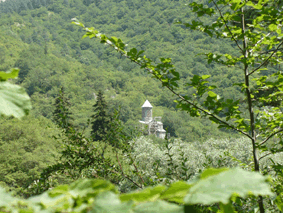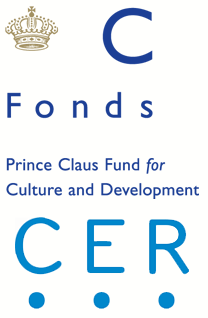
Emergency stabilisation of the Ephiscopal Palace of Nikozi monsatery complex

Implementation period: 2011
Funded by: Cultural Emergency Response” programme of the Prince Claus Fund
About the Site: The 11th century Ikvi Church of the St. George, located in Kaspi Municipality in Shida Kartli region, is among the most important landmarks of Georgia. The cross-domed church built of cut stone slabs bears the donor inscription executed in ancient Georgian Asomtavruli script, which dates the church back to the 11th century. The drum and the facades of the church are adorned with superb stone carved ornaments, which demonstrate the high craftsmanship of Georgian masons and the diversity of ornamental motifs varied from geometric to complex floral patterns.
The importance of the monument is further increased by the 12th-13th century mural painting in the interior of the church. The Ikvi murals are significant not only by their superb quality and style, characteristic for the 11th-13th centuries, but also by its iconographic program, which alongside the main Evangelic scenes like Crucifixion, Transfiguration, Nativity etc., depicts the episodes of the life and martyrdom of St George in the northern cross-arm. The murals of the western cross-arm differ from the rest of the paintings and stylistically belong to 13th century.
The Ikvi paintings, with their superb execution, flowing line and elaborate color combinations stand next to the outstanding examples of mural paintings of the Eastern Christianity. Stylistically characterized by the main features of Byzantine style, they, at the same time, are echoing the local traditions by the laconism of iconographic program and composition structure. Having similarities with other exceptional Georgian monuments, such as Ateni, Pavnisi, Kintsvisi and Timotesubani, Ikvi paintings are valuable for not only Georgian art history but also for the studies of Eastern Christian art.
The continuous (May –July) heavy rains hit the Kaspi region too. The local population of the region was inflicted by the sever losses both due the washing the houses and floating the rural holdings. The disaster also affected the 11th century Ikvi church.
The most vulnerable components of the Site are the 12th-13th century murals in the interior of the church. Even though the architectural structure of the church has been recently stabilized, the disaster caused loosen and falling of the stones from the drum, opening the access way to rainwater to the interior of the church. The mural paintings, although damaged by the time and required the conservation, were not in direct danger of destruction. But the water infiltration due to the recent damages of the drum and dome made the situation critical. The frescos were suffering from different damages. Amongst these were:
Project Activities:
Architectural rehabilitation works
- Rehabilitation of the damaged masonry around the drum;
- Cleaning and fixation of the stones on the drum of the church;
- Installation of new stones instead of lost ones;
- Replacement of old roofing;
- Glazing of the window openings.
Conservation of the Murals in the Interior of the Church:
- Consolidation of plaster by lime mortar filling and hydraulic lime injections;
- Stabilization of the plaster edges with the lime borders;
- Injection of the cracks on plaster with lime solution;
- Mechanical removal of salts using distilled water, Japanese paper and brush;
- Treatment of flecking and powdering paint by Japanese paper and 5% Primal;
- Removal of the biological deterioration on the small pieces of the painting.
Conservation of the Wall cladding in the interior and the arch of the portal
As it was mentioned above, the erection of scaffoldings in the interior during the conservation works of the church showed out existence of problematic areas in the upper parts of cross arms, where the plaster has long been fallen and close examination of the bare masonry showed that the cohesion of the mortar with stones in the joints is mostly very weak.
The endanger parts of wall in the interior have been treated with special cautiousness. The stones have been cleaned and conserved, while the mortar in the joints between stone has been removed and replaced with new lime/sand mortar, which in turn consolidated the cohesion of the masonry.
The same activities have been accomplished on the masonry of the arch of the portal.